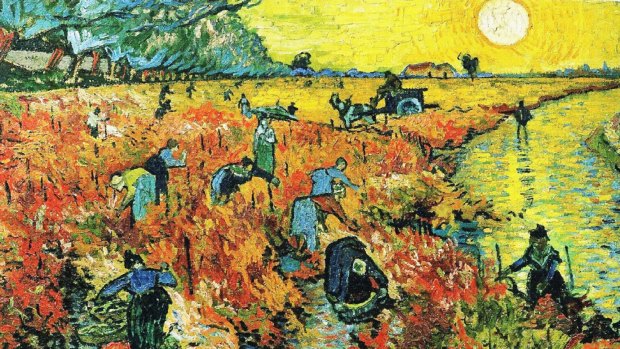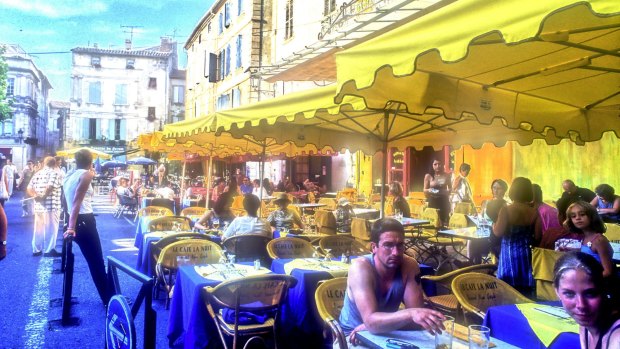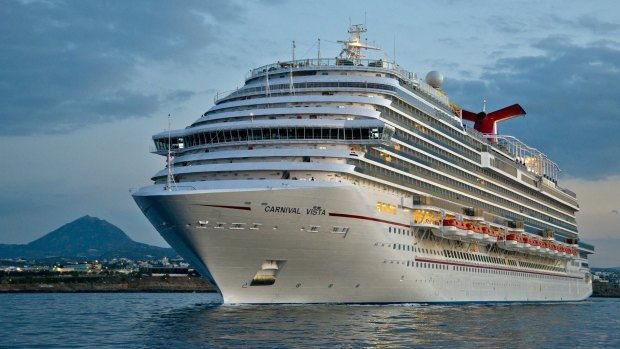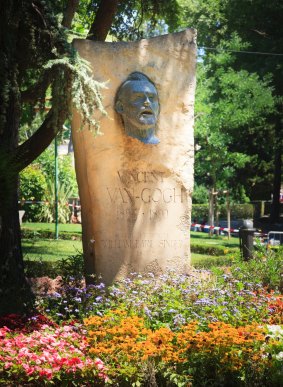By John Huxley

Vincent van Gogh's Red Vineyards at Arles.Credit: Alamy
The Greeks settled it as early as the sixth century BC. Emperor Julius Caesar established it as a Roman colony. And one of his successors Constantine the Great named it his second capital, "the little Rome of the Gauls".
The south-eastern French town of Arles – the self-styled gateway to the vast wetlands and wildlife of the Camargue – may not be as popular with travellers today as, say, nearby Avignon and Aix-en-Provence. But it still boasts some of the region's greatest attractions: vivid reminders of a visitor who spent barely a year in the town – and an increasingly unruly, unhappy and unfulfilled year at that – Dutch-born painter Vincent van Gogh.
For a comprehensive exhibition and high-tech explanation of his work, admirers must join the long queues outside the magnificent Van Gogh Museum in Amsterdam.

The Cafe la Nuit was painted by Vincent van Gogh. Credit: Alamy
But for an insight into the dramatic life and times of the artist, the colourful landscape that inspired him and the pressures that ultimately unhinged him, nothing beats a walk round Arles and the surrounding, Provencal countryside.
Van Gogh arrived in Arles in February 1888. Exhausted by the pressures of Paris and depressed by its bitter winter, he planned to create a "studio of the south", with similarly temperamental friends such as Paul Gauguin.
Quite what attracted him to jump from a south-bound train and settle in the notoriously "tawdry town" of Arles is a mystery.

The Carnival Vista visits Arles as an excursion option.
Perhaps, as Martin Gayford, author of the must-read book The Yellow House – the name of the artists' ill-fated studio, suggests, it was pure, characteristic whim.
Van Gogh, he writes, expected to spend a few months painting portraits, probably in brothels, before moving on. "Instead, he was instantly fascinated by the possibilities of the area." Its sun, its light, its dark, its vivid colours.
Within months, however, his grand design had turned from sunflowery day into a starry, starry nightmare, as the ill-matched artists clashed.

A sculpture of Vincent Van Gogh in an Arles park. Credit: Alamy
It culminated in van Gogh infamously chopping off a bit of his own ear with a razor, or – a more recent theory – having it severed by a sword-swinging Gauguin.
Within months, Gauguin had left Arles, and the "mad redhead" had been transferred by his long-suffering brother Theo into a psychiatric hospital in nearby Saint Remy de Provence.
Unfortunately, the Yellow House, the centrepiece of his frantic activity – when he was not busy in the fields, or boozing in the town brothels – was destroyed, during the Second World War by Allied bombers.
Fortunately, he left behind more than some 300 paintings and drawings of the countryside around Arles; its vibrant canals and rivers, bridges and boats, flatlands lands and towering, blue skies, farm labourers and "working" women.
Though most of the pictures are in the Amsterdam gallery, their settings remain unspoilt and surprisingly evocative.
Since my last visit, about a decade ago, famous architect Frank Gehry has completed a fascinating Vincent van Gogh cultural centre, dedicated to the work, life and legacy of the artist.
New "then and now" interpretive, information boards, have also been erected at key places, allowing visitors to compare the real, 21st-century place with the artist's interpretations.
For example, a 10-minute walk from the downtown cultural and visitor centres are Les Alyscamps, or "Elysian Fields", an ancient, crumbling Roman necropolis painted repeatedly by the two artists.
After being "lost" over the years in a maze of factories and railway lines, abandoned to lovers and litterers, the quiet burial ground has been restored.
Now as then, the poplar trees and long lines of sarcophagi offer a place of relaxation and reflection, instantly recognisable from the artists' paintings.
Of course, there is much, much more to see and enjoy in Arles, today a small, compact, laid-back, eminently tourist-friendly, town of barely 50,000 inhabitants.
On a bitter spring day when the "mistral" – a strong, north-westerly wind blew hard – we visited the must-see sights: the forum, the Roman Theatre, the Place de la Republique, the Romanesque church of St-Trophime, and the famous, first-century amphitheatre.
The gladiators, slaves, wind animals and criminals, who fought and died in the first-century stadium, may be long gone, but the towering, 25,000-seater still hosts bullfights, or "corridas".
To the dismay of some visitors, not all the bulls survive. "Not everyone approves," our guide says. "But right or wrong, it is still part of the local culture."
Van Gogh, it seems, confined himself to painting pictures of the crowds at "the bull games".
Some experts, however, suggest that, such was the impression on him, that he cut his own ear after observing the custom by which the victorious matador severed one ear of a defeated bull and, after showing it to the crowd, presented it to a lady.
TRIP NOTES
MORE INFORMATION
arlestourisme.com; carnival.com.au
CRUISING THERE
Arles was one of the excursion options on the Carnival Vista, which will operate eight-to-13-day Mediterranean cruises until November, when it will reposition in New York for a pair of 11-day voyages before launching a year-round Caribbean service from Miami. Its sister ship, Carnival Visit, offers a choice of short voyages from Sydney.
John Huxley travelled as a guest of Carnival Cruise Line.
Sign up for the Traveller Deals newsletter
Get exclusive travel deals delivered straight to your inbox. Sign up now.